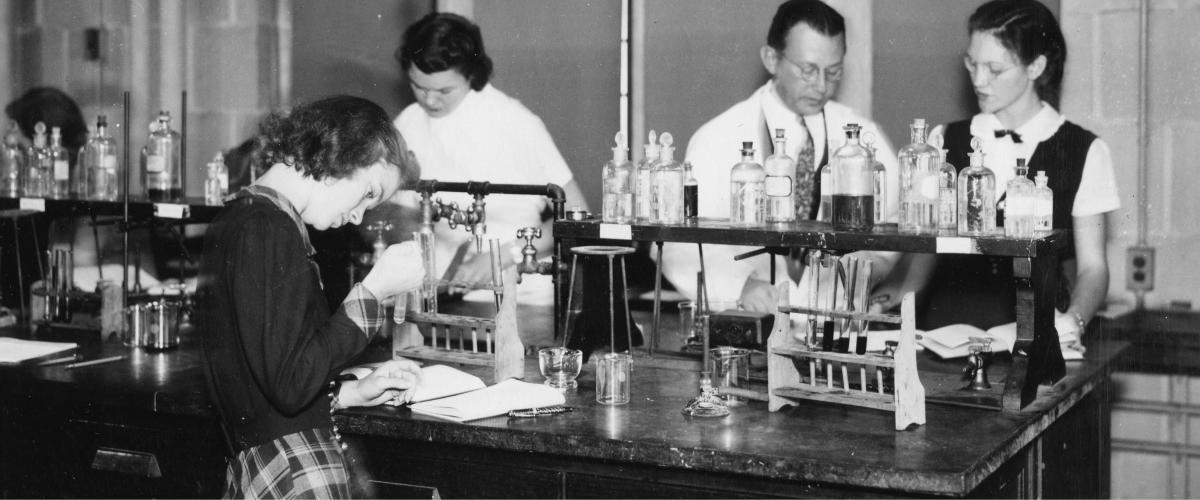
The Department of Biochemistry, Yesterday and Today
The Department of Biochemistry was established in 1930 concurrent with the founding of the Duke University School of Medicine. The initial mission of the Department was to teach biochemistry to first-year medical students and supervise the clinical chemistry laboratory of Duke Hospital. Shortly thereafter, the Department was given the authority to award the PhD degree thereby setting in motion its research mission to understand the biochemical processes of life. Hence, Biochemistry at Duke University has had a long and storied history, with only five Chairs having led the department since its inception. The Founding Chair was William A. Perlzweig (1930-1950), followed by Philip Handler (1950-1969), Robert L. Hill (1969-1993), and Christian R.H. Raetz (1993-2007). Peter Agre and then Kenneth Kreuzer served as Interim Chairs during a transition period from 2007-2010, after which Richard G. Brennan was chosen to serve as Chair in early 2011.
During its first twenty years, the Department was housed in the Davison Building. In the 1940s, there were only eight faculty members: William A. Perlzweig, Hans Neurath, Jerome Harris, Frank W. Putnam, George W. Schwert, W.F.H.M. Mommaerts, Mary L.C. Benheim, Philip Handler, and Haywood Taylor. Putnam and Schwert later moved to other universities to head their biochemistry departments and in 1950 Hans Neurath left Duke to become the founding chair of the Department of Biochemistry at the University of Washington. In recognition of their contributions to biochemistry, much of which was carried out at Duke, Putnam, and Neurath were elected to the National Academy of Sciences.
In 1950, Philip Handler became the Chair of the Department and during the next 15 years, he expanded the number of faculty members to 21, graduate students to 60, and initiated the of training postdoctoral research associates. Handler stepped down in 1969 to become the 18th President of the National Academy of Sciences, a post he held for two consecutive six-year terms.
After Handler took his post at the NAS, the Department continued to develop under Hill and moved to its current home in the Nanaline H. Duke Building. Hill brought in macromolecular crystallographers and other faculty with expertise in DNA and RNA biochemistry and further strengthened its research efforts in molecular biology and protein and enzyme chemistry. In 1993, Raetz succeeded Hill as Chair and recruited current members Meta Kuehn and Pei Zhou. When Raetz stepped down in 2007, Kenneth Kreuzer became “Interim” Chair and together with the Ion Channel Research Unit carried out the successful recruitment of Seok-Yong Lee, an outstanding membrane protein structural biologist. Brennan was recruited to lead the Department in 2011 and has since brought in additional outstanding scientists including, Maria A. Schumacher, Kenichi Yokoyama, Michael S. Boyce, G. Vann Bennett, Hashim M. Al-Hashimi, Huanghe Yang, Kate D. Meyer, and Alberto Bartesaghi, who is also a member of the Department of Computer Science. These new faculty members have added to the considerable strength of the Department in the fields of protein and nucleic acid biochemistry and its growing expertise in signal transduction, membrane-related phenomena, molecular neurobiology, and computational and structural biology. Several of these newer faculty members have brought innovative and exciting programs in the broader areas of cellular biochemistry, molecular microbiology, molecular science, and cryo-electron microscopy, thereby significantly expanding its scientific depth, reach, and interests.
The Department has a broad educational mission including the training and teaching of undergraduates, graduate students, and medical students, and engaging in cutting-edge research that elucidates the molecular and structural nature of biological processes with fundamental discoveries that will transform our understanding of essential life processes and enhance human health. As of 2025, there are 20 primary and 13 secondary faculty members, seven emeritus members, two adjunct professors, nearly 43 graduate students, and 22 postdoctoral fellows and research associates. The Department occupies approximately 35,000 sq. ft. in the Nanaline Duke Building and 5,500 sq. ft. in the adjacent Sands Building.
The Department sits adjacent to six other basic science departments within the Duke University School of Medicine thereby promoting frequent interdepartmental interactions and productive collaborations. Our research and teaching missions also benefit from our physical proximity to the main campus and the Mary Duke Biddle Trent Semans Center for Health Education. The main quad (the Abele Quad) of Duke University, the gothic Duke Chapel and pristine Duke Gardens, the School of Engineering, the Departments of Chemistry, Biology, Physics, and Computer Science, and even the legendary Cameron Indoor Stadium, are all within walking distance of the Nanaline Duke Building.
Our world-class research programs have been recognized by highly cited publications and our findings have been included in textbooks. Many of our faculty have taken on major journal editorships, provide worldwide research resources, such as MolProbity, and have been recognized by numerous awards including two Nobel Prizes in Chemistry given to Professors Robert J. Lefkowitz in 2012 and Paul L. Modrich in 2015. Furthermore, our faculty research has been recognized by memberships in the Howard Hughes Medical Institute, the election of multiple members to the National Academy of Sciences and to other honor societies including the American Academy of Arts and Sciences, the National Academy of Medicine, the American Academy of Microbiology and the American Academy for the Advancement of Science. Currently, eight primary faculty members hold endowed professorships and our newest faculty members have garnered multiple scholarships and young investigator awards from agencies such as the Rita Allen, Kimmel, Searle, and Klingenstein-Simons Foundations as well as NIH Director’s New Innovator Awards and NIH Avenir Award, all presaging continued research excellence in the Department.